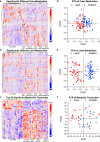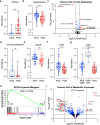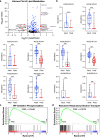Metabolic profiling of adult and pediatric gliomas reveals enriched glucose availability in pediatric gliomas and increased fatty acid oxidation in adult gliomas
- PMID: 40087788
- PMCID: PMC11909955
- DOI: 10.1186/s40478-025-01961-w
Metabolic profiling of adult and pediatric gliomas reveals enriched glucose availability in pediatric gliomas and increased fatty acid oxidation in adult gliomas
Abstract
Gliomas are the most common primary brain tumors and a major source of mortality and morbidity in adults and children. Recent genomic studies have identified multiple molecular subtypes; however metabolic characterization of these tumors has thus far been limited. We performed metabolic profiling of 114 adult and pediatric primary gliomas and integrated metabolomic data with transcriptomics and DNA methylation classes. We identified that pediatric tumors have higher levels of glucose and reduced lactate compared to adult tumors regardless of underlying genetics or grade, suggesting differences in availability of glucose and/or utilization of glucose for downstream pathways. Differences in glucose utilization in pediatric gliomas may be facilitated through overexpression of SLC2A4, which encodes the insulin-stimulated glucose transporter GLUT4. Transcriptomic comparison of adult and pediatric tumors suggests that adult tumors may have limited access to glucose and experience more hypoxia, which is supported by enrichment of lactate, 2-hydroxyglutarate (2-HG), even in isocitrate dehydrogenase (IDH) wild-type tumors, and 3-hydroxybutyrate, a ketone body that is produced by oxidation of fatty acids and ketogenic amino acids during periods of glucose scarcity. Our data support adult tumors relying more on fatty acid oxidation, as they have an abundance of acyl carnitines compared to pediatric tumors and have significant enrichment of transcripts needed for oxidative phosphorylation. Our findings suggest striking differences exist in the metabolism of pediatric and adult gliomas, which can provide new insight into metabolic vulnerabilities for therapy.
Keywords: Adult glioma; Fatty acid oxidation; Glucose; H3 mutant; Metabolic profiling; Pediatric glioma.
© 2025. The Author(s).
Conflict of interest statement
Declarations. Ethics approval and consent to participate: All tumors were collected upon obtaining informed consent approved by Institutional Review Board (IRB#: S12-00865). Consent for publication: Not applicable. Competing interests: M.S. is scientific advisor and shareholder of Heidelberg Epignostix and Halo Dx, and a scientific advisor of Arima Genomics, and InnoSIGN and received research funding from Lilly USA. Other authors declare no conflict of interest.
Figures






References
-
- Schwartzentruber J, Korshunov A, Liu XY et al (2012) Driver mutations in histone H3.3 and chromatin remodelling genes in paediatric glioblastoma. Nature. 482(7384):226–31. 10.1038/nature10833 - PubMed
Publication types
MeSH terms
Substances
Grants and funding
LinkOut - more resources
Full Text Sources
Medical

